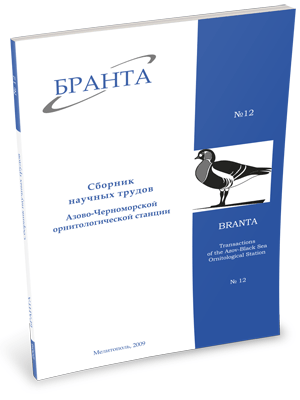
Transactions
of the Azov-Black Sea Ornithological Station



Common Buzzard (Buteo buteo) in Mykolaiv Region.
Redinov K.O.
The data were collected on two permanent plots (fig.1), and in expeditions of 1991-2008. InNikolayev region argricultural areas occupies 86% of land, and 7% are forested. First breeding finds of the Buzzard (Buteobuteo vulpinus) are known since late 1930s (fig.1, Table) in planted forests. Until 1970s the Buzzard was a rarer breeder. In 1980s the species increased in numbers and began occupying agrocoenoses. In next years species rapidly settled the area. On permanent plots the Buzzard breeding density is 0.43-0.45 pairs on 10 km2. Present numbers of the Buzzard is estimated as 500 pairs.
Spring migration is in February-early May. Autumn migration - in late August-October. It is mass migrant in marine regions, flocks contain up to 100 ind. (autumn). Since 2000s is registered on wintering.
The Buzzard arrives to breeding sites in the third decade of March – second decade of April. Usually builts nests itself. In agricultural landscape the distance between nests (n=23) equals to: 0.5 – 5 (2.2) km. Nests (n=44) are found on deciduous trees of 9 kinds at height (n=38): 2.5-12 (7.1 ± 0.4) m. Nest dimensions: D (n=8) – 54.76 (32-80); d (n=7) – 20.4 (17-24); H (n=6) – 32.5 (20-50); h (n=6) – 8 (5-10) cm.
Clutches appeared in the third decade of April – second decade of May (fig.2). In inspected nests (n=27) were 1-4 (2.69 ± 0.17) eggs or chicks. Buzzards lay eggs with an interval of approximately 48 hours. Regular incubation begins with appearance of the second egg. Duration of incubation period for the clutch of 4 eggs, from the moment of appearance of the first egg to hatching a chick out of the forth egg is about 38 days.
Chicks hatched in the third decade of May – second decade of June. After 37-45 days they become fully fledged. Broods for some time stay near nests, later moved to hunting places. The latest date of a brood observation is 28.08.2005.
Main prey is mouse-like rodents. Maximum distance of hunting area from the nest is at least 3 km. Minimal distance between the nest and human settlement is 0.6, between the nest and road with hard surface – 0.1 km. Of 24 breeding cases 19 (79%) were successful.
Read the paper in a PDF file